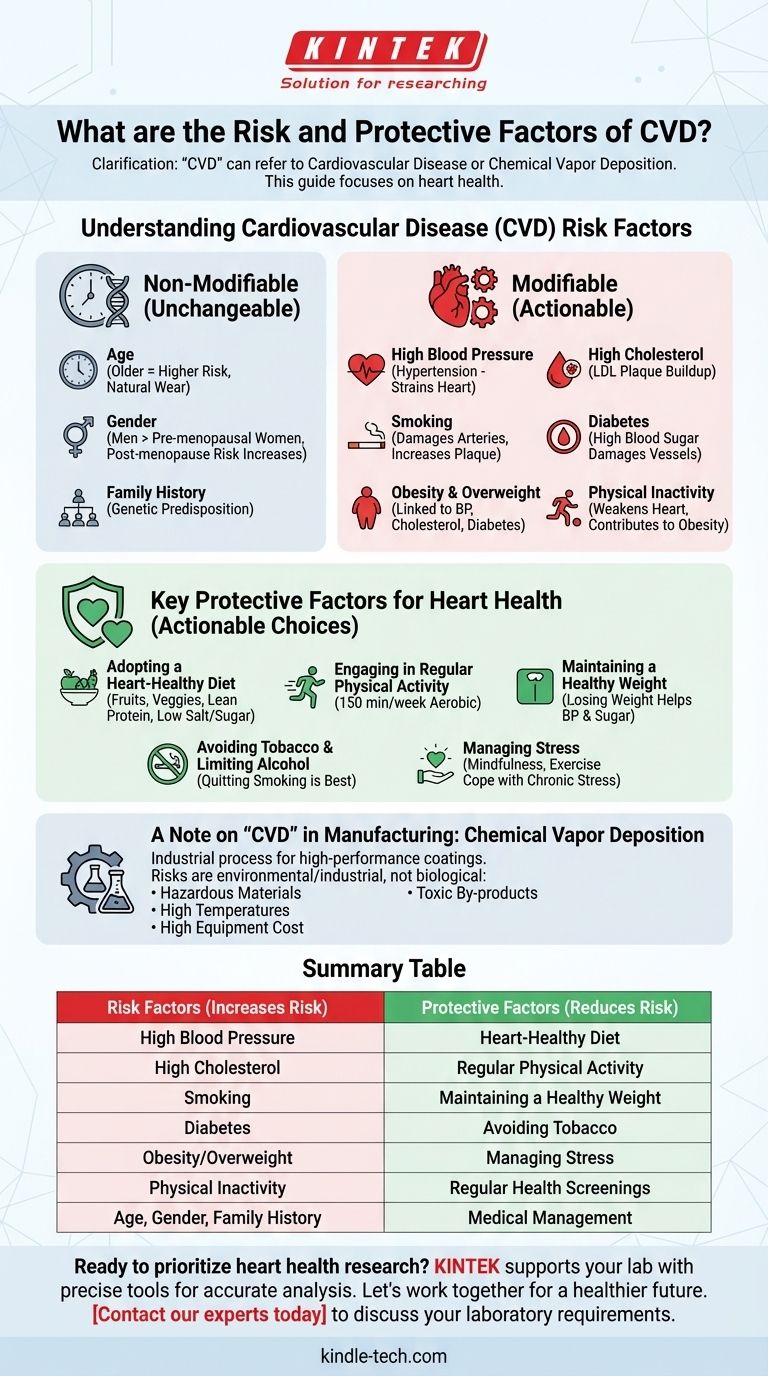It is critical to clarify that the acronym "CVD" can refer to two vastly different subjects: Cardiovascular Disease, a major health concern, or Chemical Vapor Deposition, a manufacturing process. Based on the common use of this question, this guide will focus on the risk and protective factors for Cardiovascular Disease, while also clarifying the risks associated with the manufacturing process based on the provided reference material.
The central takeaway is that while some risk factors for Cardiovascular Disease are beyond our control, a significant number are modifiable through lifestyle choices and medical management, allowing individuals to actively protect their heart health.

Understanding Cardiovascular Disease (CVD) Risk
Cardiovascular disease is a class of diseases that involve the heart or blood vessels. Understanding the factors that contribute to or protect against CVD is the first step toward prevention and management. These factors are typically divided into two categories: non-modifiable and modifiable.
Non-Modifiable Risk Factors (What you cannot change)
These are characteristics you are born with or that are a natural part of aging. They increase your baseline risk and highlight the importance of managing the factors you can control.
Age As you get older, your risk for CVD increases. Your heart and blood vessels work harder over your lifetime, leading to natural wear and tear.
Gender Men are generally at a higher risk of heart disease than pre-menopausal women. However, a woman's risk increases significantly after menopause.
Family History A family history of early heart disease is a significant risk factor. This indicates a potential genetic predisposition to conditions that affect heart health.
Modifiable Risk Factors (What you can change)
These are the most critical factors to focus on, as they are directly influenced by your lifestyle, habits, and medical care.
High Blood Pressure (Hypertension) Consistently high blood pressure forces your heart to work harder to pump blood, which can strain the heart muscle and damage artery walls over time.
High Cholesterol High levels of LDL ("bad") cholesterol can lead to the formation of plaque in your arteries, a condition known as atherosclerosis. This plaque narrows the arteries, restricting blood flow.
Smoking Smoking damages the lining of your arteries, increases fatty buildup (atherosclerosis), raises "bad" cholesterol, and reduces "good" cholesterol. It is one of the most significant risk factors.
Diabetes High blood sugar levels associated with diabetes can damage blood vessels and the nerves that control your heart, dramatically increasing CVD risk.
Obesity and Overweight Excess weight, particularly around the abdomen, is linked to high blood pressure, high cholesterol, and diabetes, all of which are major drivers of CVD.
Physical Inactivity A sedentary lifestyle contributes to obesity and other risk factors. Regular physical activity strengthens the heart and improves circulation.
Key Protective Factors for Heart Health
Protective factors are actions and choices that actively lower your risk of developing Cardiovascular Disease. They often work by directly counteracting the modifiable risk factors.
Adopting a Heart-Healthy Diet
Eating a diet rich in fruits, vegetables, whole grains, and lean proteins while low in saturated fats, trans fats, sodium, and added sugar helps manage weight, blood pressure, and cholesterol.
Engaging in Regular Physical Activity
Aim for at least 150 minutes of moderate-intensity aerobic exercise per week. This strengthens the heart muscle, improves blood flow, and helps maintain a healthy weight.
Maintaining a Healthy Weight
Losing even a small amount of weight if you are overweight can have a significant positive impact on your blood pressure and blood sugar levels.
Avoiding Tobacco and Limiting Alcohol
Quitting smoking is the single best thing you can do for your heart health. Limiting alcohol consumption can also help lower blood pressure.
Managing Stress
Chronic stress can contribute to high blood pressure and other unhealthy behaviors. Finding healthy ways to cope with stress, such as mindfulness or exercise, is protective.
A Note on "CVD" in Manufacturing: Chemical Vapor Deposition
For clarity, the provided references discuss the risks of a completely different "CVD": Chemical Vapor Deposition. This is an industrial process used to produce high-performance coatings and materials.
The risks associated with this process are purely industrial and environmental, not biological. They include:
- Use of hazardous materials: Many source materials are toxic, flammable, or corrosive, requiring strict safety protocols and protective equipment.
- High temperatures: The process often requires high heat, which can create residual stress in the finished materials.
- Toxic by-products: The chemical reactions can produce hazardous waste that must be managed carefully.
- High equipment cost: The specialized nature of the equipment and safety systems makes it an expensive process.
Making the Right Choice for Your Health
Understanding your personal risk profile is key to protecting yourself from Cardiovascular Disease.
- If your primary focus is prevention: Adopt protective lifestyle habits like a balanced diet, regular exercise, and avoiding tobacco, regardless of your family history.
- If you have known modifiable risk factors (like high blood pressure): Work closely with your doctor on a management plan that includes lifestyle changes and, if necessary, medication.
- If you have significant non-modifiable risks (like a strong family history): Be extra vigilant about managing the factors you can control and adhere to recommended medical screenings.
Ultimately, taking proactive control of your modifiable risk factors is the most powerful tool you have to ensure long-term heart health.
Summary Table:
| Risk Factors (What Increases Risk) | Protective Factors (What Reduces Risk) |
|---|---|
| High Blood Pressure | Heart-Healthy Diet |
| High Cholesterol | Regular Physical Activity |
| Smoking | Maintaining a Healthy Weight |
| Diabetes | Avoiding Tobacco |
| Obesity/Overweight | Managing Stress |
| Physical Inactivity | Regular Health Screenings |
| Age, Gender, Family History | Medical Management of Conditions |
Ready to prioritize your heart health? Understanding your personal risk factors is the first step. The KINTEK team is dedicated to supporting health research and diagnostics with reliable laboratory equipment. Whether you're a researcher studying cardiovascular disease or a healthcare professional, KINTEK provides the precise tools you need for accurate analysis. Let's work together for a healthier future. Contact our experts today to discuss your laboratory requirements.
Visual Guide

Related Products
- Inclined Rotary Plasma Enhanced Chemical Vapor Deposition PECVD Equipment Tube Furnace Machine
- Chemical Vapor Deposition CVD Equipment System Chamber Slide PECVD Tube Furnace with Liquid Gasifier PECVD Machine
- RF PECVD System Radio Frequency Plasma-Enhanced Chemical Vapor Deposition RF PECVD
- Customer Made Versatile CVD Tube Furnace Chemical Vapor Deposition Chamber System Equipment
- Split Chamber CVD Tube Furnace with Vacuum Station Chemical Vapor Deposition System Equipment Machine
People Also Ask
- What is plasma in CVD process? Lowering Deposition Temperatures for Heat-Sensitive Materials
- What is the difference between CVD and PECVD? Choose the Right Thin-Film Deposition Method
- What is the difference between PECVD and CVD? Unlock the Right Thin-Film Deposition Method
- What is plasma enhanced chemical vapor deposition? Achieve Low-Temperature, High-Quality Thin Films
- How does plasma enhanced CVD work? Achieve Low-Temperature, High-Quality Thin Film Deposition



















